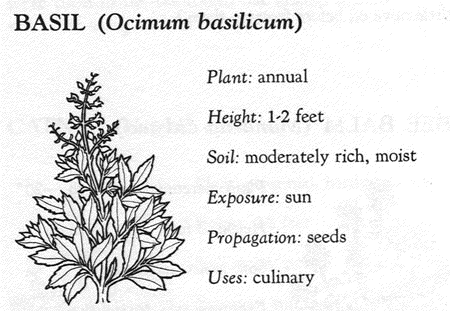
FoodFood InformationHerbs&Spice
BASIL (Ocimum basilicum)
The basils are attractive annual herbs with a sharp, spicy flavor and long
history of use. There are several species, but the plants most commonly
grown for culinary and ornamental values are O. basilicum and its varieties.
Sweet basil (O. basilicum) grows to about 2 feet high and has shiny green
leaves that are 12 inches long. Small white flowers grow in spikes at the
ends of the stems. If the stem tips are pinched out frequently, sweet basil
will grow bushy and full, making it an attractive border plant. This species
is the most popular one for cooking. The variety 'Dark Opal' won an All
America bronze medal for its decorative, purple bronze foliage and spikes
of small lavender pink flowers. Bush basil (O. b. minimum) has more branches
and a more compact growth than sweet basil. The leaves are much smaller,
and the edges curl inward toward the center vein. It grows to about 1 1/2
feet tall.
Basil has a rich history, but the stories about it often are contradictory.
In Italy, basil is associated with sympathy and compassion which is supposed
to arise between those who wear sprigs of it. In other countries, basil
is a sign of love and devotion between young couples. A few 16th and 17th
century herbalist's have a different idea of its nature and associate it
with scorpions and poison: One recommended placing basil leaves on the bites
and stings of poisonous snakes and insects, saying that "Every like
draws its like" certainly the opposite of its ability to attract two
lovers.
All basil can be grown in full sun or semi shade and a warm, moderately
rich soil. They should not be fertilized as flavor is likely to be sacrificed
for lush growth. Water regularly to keep growth succulent and the leaves
fresh. Indoors, basil requires sun and should be pinched occasionally to
keep growth bushy. Basil grows readily from seeds sown in the spring as
soon as the ground is warm.
The leaves have a spicy, clove like flavor that is an excellent complement
to such foods as eggs, cheese, fish, poultry, stuffing, salads, meats, and
spaghetti. It is especially good in tomato dishes. Use either the fresh
or cured leaves. Preserve them by freezing or packing in salt. (You might
try chopping the fresh leaves and adding a little olive oil before freezing
them.)
